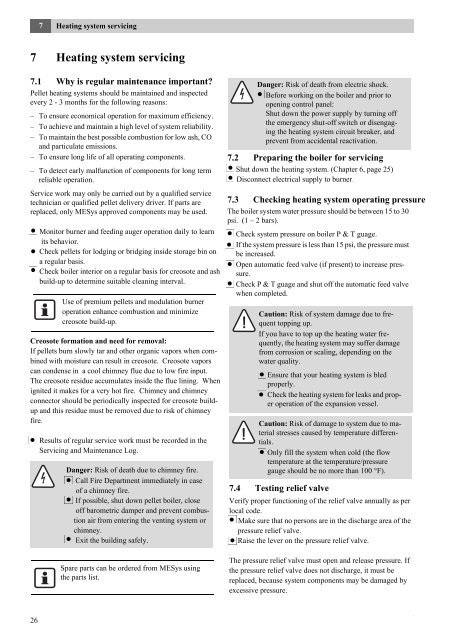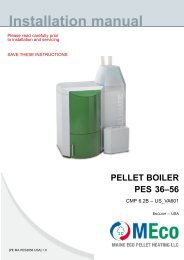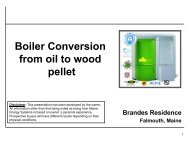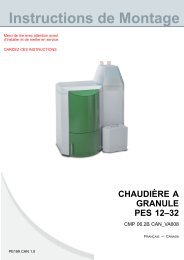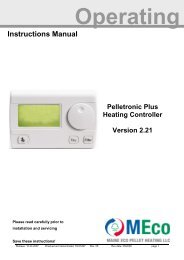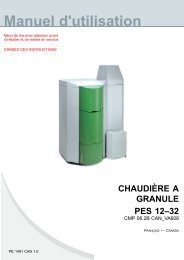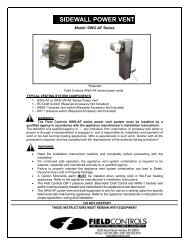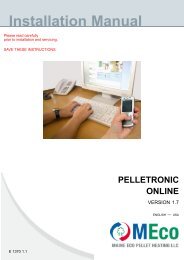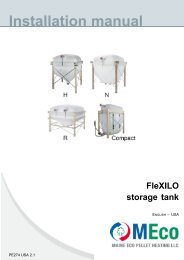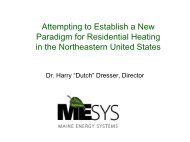Wood Pellet Cast Iron Boiler MESys 4000 - Maine Energy Systems
Wood Pellet Cast Iron Boiler MESys 4000 - Maine Energy Systems
Wood Pellet Cast Iron Boiler MESys 4000 - Maine Energy Systems
Create successful ePaper yourself
Turn your PDF publications into a flip-book with our unique Google optimized e-Paper software.
26<br />
7 Heating system servicing<br />
7 Heating system servicing<br />
7.1 Why is regular maintenance important?<br />
Danger: Risk of death from electric shock.<br />
<strong>Pellet</strong> heating systems should be maintained and inspected<br />
every 2 - 3 months for the following reasons:<br />
V� V Before working on the boiler and prior to<br />
opening control panel:<br />
– To ensure economical operation for maximum efficiency.<br />
– To achieve and maintain a high level of system reliability.<br />
– To maintain the best possible combustion for low ash, CO<br />
and particulate emissions.<br />
Shut down the power supply by turning off<br />
the emergency emergency shut-off switch or disengagdisengaging the heating system circuit breaker, and<br />
prevent from accidental accidental reactivation. reactivation.<br />
– To ensure long life of all operating components. 7.2 Preparing the boiler for servicing<br />
– To detect early malfunction of components for long term V� Shut down the heating system. (Chapter 6, page 25)<br />
reliable operation.<br />
V � Disconnect electrical supply to burner. �<br />
Service work may only be carried out by a qualified service<br />
technician or qualified pellet delivery driver. If parts are<br />
�<br />
7.3 Checking heating system operating pressure<br />
replaced, only <strong>MESys</strong> approved components may be used. The boiler system water pressure should be between 15 to 30<br />
psi. (1 – 2 bars).<br />
V � Monitor burner and feeding auger operation daily to learn<br />
its behavior.<br />
V � Check pellets for lodging or bridging inside storage bin on<br />
�V<br />
Check system pressure on boiler P & T guage.<br />
�V<br />
If the system pressure is less than 15 psi, the pressure must<br />
be increased.<br />
a regular basis.<br />
V � Check boiler interior on a regular basis for creosote and ash<br />
�V<br />
Open automatic feed valve (if present) to increase pressure.<br />
build-up to determine suitable cleaning interval.<br />
�V<br />
Check P & T guage and shut off the automatic feed valve<br />
when completed.<br />
Creosote formation and need for removal:<br />
If pellets burn slowly tar and other organic vapors when combined<br />
with moisture can result in creosote. Creosote vapors<br />
can condense in a cool chimney flue due to low fire input.<br />
The creosote residue accumulates inside the flue lining. When<br />
ignited it makes for a very hot fire. Chimney and chimney<br />
connector should be periodically inspected for creosote buildup<br />
and this residue must be removed due to risk of chimney<br />
fire.<br />
�V<br />
Results of regular service work must be recorded in the<br />
Servicing and Maintenance Log.<br />
� (�<br />
Use of premium pellets and modulation burner<br />
operation enhance combustion and minimize<br />
creosote build-up.<br />
Danger: Risk of death due to chimney fire.<br />
�V<br />
Call Fire Department immediately in case<br />
of a chimney fire.<br />
�V<br />
If possible, shut down pellet boiler, close<br />
off barometric damper and prevent combustion<br />
air from entering the venting system or<br />
chimney.<br />
�V<br />
Exit the building safely.<br />
Spare parts can be ordered from <strong>MESys</strong> using<br />
the parts list.<br />
� �<br />
Caution: Risk of system damage due to frequent<br />
topping up.<br />
If you have to top up the heating water frequently,<br />
the heating system may suffer damage<br />
from corrosion or scaling, depending on the<br />
water quality.<br />
V� Ensure that your heating system is bled<br />
properly.<br />
�V<br />
Check the heating system for leaks and proper<br />
operation of the expansion vessel.<br />
Caution: Risk of damage to system due to material<br />
stresses caused by temperature differentials.<br />
V� Only fill the system when cold (the flow<br />
temperature at the temperature/pressure<br />
gauge should be no more than 100 °F).<br />
7.4 Testing relief valve<br />
Verify proper functioning of the relief valve annually as per<br />
local code.<br />
V� Make sure that no persons are in the discharge area of the<br />
pressure relief valve.<br />
V� Raise the lever on the pressure relief valve.<br />
The pressure relief valve must open and release pressure. If<br />
the pressure relief valve does not discharge, it must be<br />
replaced, because system components may be damaged by<br />
excessive pressure.


